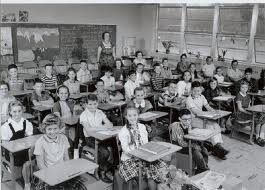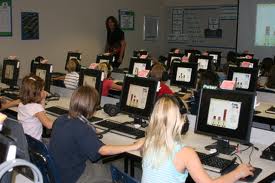Schools are equipped with computers and wifi, and students are coming to school as experts in these new technologies (Alexander, 2008). As students become more expert at web 2.0 tools such as blogging, social networking, and sharing images, they become less engaged in the technology that schools have to offer. Teachers are now recognizing the potential web 2.0 holds in engaging our students in educational activities and are slowly bringing them into the classroom as educational tools. Web 2.0 has revolutionized the internet, and it is beginning to revolutionize the classroom. Alexander (2006) lists a variety of web 2.0 tools that are being used in the classroom, but teachers are still relatively slow at fully integrating web 2.0. Changing the classroom is a difficult thing to do. Fifty years ago the classroom was very much a teacher centred structure:

Then the emergence of computer education provided the potential to break away from the traditional classroom. What we got was more of the same:

Adults struggle with issues related to web 2.0, such as safety and access, while children are becoming experts with all of the tools that web 2.0 provides (Livingstone, & Haddon, 2008). While these adults are coming to terms with the new technology nearly half of post-secondary students have contributed photos or video online, 2 in 5 have contributed to wikis, and 1 in 3 have blogged, all before they are finished high school (Diaz, 2010). These are all features that require social awareness, contribution, at least a basic understanding of literacy, and a connection to people with similar interests. While many adults are grappling with the question of whether it is appropriate to bring these technologies in the classroom, students are using them ubiquitously, and are subsequently becoming online authors without the encouragement or direction of anyone else (Alexander, 2008; Yancey, 2004).
Connectivity and literacy are some of the tools that initiate the excitement when considering web 2.0 as a learning tool in the classroom. Web sites that are built for people to connect, such as Flickr and Facebook, are filling the web (Alexander, 2008). However, social networking and sharing of information are areas that make adults wary of introducing web 2.0 tools in the classroom.
Evidence might suggest that too much caution is unwarranted. The internet, and web 2.0 especially, has created a shift in reading and writing that has not been seen since newspapers and mass produced books first made reading accessible to a large audience (Yancey, 2004). Not only is writing in web 2.0 accessible to anyone with a computer or a cell phone it is deeply communal. Anyone with a particular interest can find thousands of people with a similar interest and learn with and from each them. Collaborating together online creates a vast amount of knowledge as demonstrated by the hugely popular website Wikipedia.com (Dobson and Willinsky, 2009).
The ubiquitous use of web 2.0 tools leaves people in a typical authority position, such as parents and teachers, with virtually no authority when it comes to creating online text (Bolter, 2001). Authority is being replaced by flexibility and collaboration. As web 2.0 writing takes off, the typical authority figure’s role, while drastically changed, becomes vitally important. However, instead of the traditional tactic of delivering direction from the front of a classroom, a teacher must now equip students with the skills necessary to recognize that they are actually writing when they are online and sharing photos, or updating a status. The web 2.0 examples provided by people such as Alexander (2006) in ‘Web 2.0: A New Wave of Innovation for Teaching and Learning?’ are examples that teachers can use to equip students with the skills and experiences necessary to be consumers and contributors to the internet.
Web 2.0 has changed the way the classroom looks as teachers are no longer the experts. Students can be proficient in using the technology and teachers have the ability to encourage real learning that is student centred. The internet has changed because of web 2.0 tools, so have the users of the internet, our children, and now our classrooms are beginning to make that same transformation.
References
Alexander, B. (2008). Web 2.0 and Emergent Multiliteracies. Theory Into Practice 41 p.150-160. doi: 10.1080/00405840801992371
Alexander, B. (2006). Web 2.0: A new wave of innovation for teaching and learning? Educause Review, 41(2), 34-44. Retrieved from: http://net.educause.edu/ir/library/pdf/ERM0621.pdf
Bolter, J.D. (2001). Writing Space: Computers, Hypertext, and the Remediation of Print. Routledge Taylor & Francis Group, New York, NY.
Diaz, V. (2010). Web 2.0 and Emerging Technologies in Online Learning. Online Education 2010(150) 57-66. doi: 10.1002/cc.405
Dobson, T., and Willinksy (2009). Digital Literacy. In David R. Olson, and Nancy Torrance (Eds.), The Cambridge Handbook of Literacy (pp.286-312). New York, NY: Cambridge University Press.
Livingstone, S., & Haddon L. (2008). Risky experiences for children online: Charting European research on children and the Internet. Children & Society 22 314–323. doi: 10.1111/j.1099-0860.2008.00157.x
Yancey, K.B. (2004). Made Not Only in Words: Composition in a New Key. College Composition and Communication. 56(2) p.297-329.

































Commentary 3 – Web 2.0: Creating New Students and New Educators
Schools are equipped with computers and wifi, and students are coming to school as experts in these new technologies (Alexander, 2008). As students become more expert at web 2.0 tools such as blogging, social networking, and sharing images, they become less engaged in the technology that schools have to offer. Teachers are now recognizing the potential web 2.0 holds in engaging our students in educational activities and are slowly bringing them into the classroom as educational tools. Web 2.0 has revolutionized the internet, and it is beginning to revolutionize the classroom. Alexander (2006) lists a variety of web 2.0 tools that are being used in the classroom, but teachers are still relatively slow at fully integrating web 2.0. Changing the classroom is a difficult thing to do. Fifty years ago the classroom was very much a teacher centred structure:
Then the emergence of computer education provided the potential to break away from the traditional classroom. What we got was more of the same:
Adults struggle with issues related to web 2.0, such as safety and access, while children are becoming experts with all of the tools that web 2.0 provides (Livingstone, & Haddon, 2008). While these adults are coming to terms with the new technology nearly half of post-secondary students have contributed photos or video online, 2 in 5 have contributed to wikis, and 1 in 3 have blogged, all before they are finished high school (Diaz, 2010). These are all features that require social awareness, contribution, at least a basic understanding of literacy, and a connection to people with similar interests. While many adults are grappling with the question of whether it is appropriate to bring these technologies in the classroom, students are using them ubiquitously, and are subsequently becoming online authors without the encouragement or direction of anyone else (Alexander, 2008; Yancey, 2004).
Connectivity and literacy are some of the tools that initiate the excitement when considering web 2.0 as a learning tool in the classroom. Web sites that are built for people to connect, such as Flickr and Facebook, are filling the web (Alexander, 2008). However, social networking and sharing of information are areas that make adults wary of introducing web 2.0 tools in the classroom.
Evidence might suggest that too much caution is unwarranted. The internet, and web 2.0 especially, has created a shift in reading and writing that has not been seen since newspapers and mass produced books first made reading accessible to a large audience (Yancey, 2004). Not only is writing in web 2.0 accessible to anyone with a computer or a cell phone it is deeply communal. Anyone with a particular interest can find thousands of people with a similar interest and learn with and from each them. Collaborating together online creates a vast amount of knowledge as demonstrated by the hugely popular website Wikipedia.com (Dobson and Willinsky, 2009).
The ubiquitous use of web 2.0 tools leaves people in a typical authority position, such as parents and teachers, with virtually no authority when it comes to creating online text (Bolter, 2001). Authority is being replaced by flexibility and collaboration. As web 2.0 writing takes off, the typical authority figure’s role, while drastically changed, becomes vitally important. However, instead of the traditional tactic of delivering direction from the front of a classroom, a teacher must now equip students with the skills necessary to recognize that they are actually writing when they are online and sharing photos, or updating a status. The web 2.0 examples provided by people such as Alexander (2006) in ‘Web 2.0: A New Wave of Innovation for Teaching and Learning?’ are examples that teachers can use to equip students with the skills and experiences necessary to be consumers and contributors to the internet.
Web 2.0 has changed the way the classroom looks as teachers are no longer the experts. Students can be proficient in using the technology and teachers have the ability to encourage real learning that is student centred. The internet has changed because of web 2.0 tools, so have the users of the internet, our children, and now our classrooms are beginning to make that same transformation.
References
Alexander, B. (2008). Web 2.0 and Emergent Multiliteracies. Theory Into Practice 41 p.150-160. doi: 10.1080/00405840801992371
Alexander, B. (2006). Web 2.0: A new wave of innovation for teaching and learning? Educause Review, 41(2), 34-44. Retrieved from: http://net.educause.edu/ir/library/pdf/ERM0621.pdf
Bolter, J.D. (2001). Writing Space: Computers, Hypertext, and the Remediation of Print. Routledge Taylor & Francis Group, New York, NY.
Diaz, V. (2010). Web 2.0 and Emerging Technologies in Online Learning. Online Education 2010(150) 57-66. doi: 10.1002/cc.405
Dobson, T., and Willinksy (2009). Digital Literacy. In David R. Olson, and Nancy Torrance (Eds.), The Cambridge Handbook of Literacy (pp.286-312). New York, NY: Cambridge University Press.
Livingstone, S., & Haddon L. (2008). Risky experiences for children online: Charting European research on children and the Internet. Children & Society 22 314–323. doi: 10.1111/j.1099-0860.2008.00157.x
Yancey, K.B. (2004). Made Not Only in Words: Composition in a New Key. College Composition and Communication. 56(2) p.297-329.